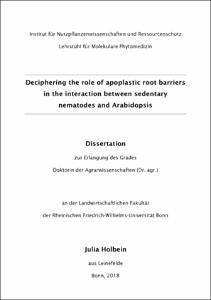Holbein, Julia: Deciphering the role of apoplastic root barriers in the interaction between sedentary nematodes and Arabidopsis. - Bonn, 2018. - Dissertation, Rheinische Friedrich-Wilhelms-Universität Bonn.
Online-Ausgabe in bonndoc: https://nbn-resolving.org/urn:nbn:de:hbz:5n-53007
Online-Ausgabe in bonndoc: https://nbn-resolving.org/urn:nbn:de:hbz:5n-53007
@phdthesis{handle:20.500.11811/7390,
urn: https://nbn-resolving.org/urn:nbn:de:hbz:5n-53007,
author = {{Julia Holbein}},
title = {Deciphering the role of apoplastic root barriers in the interaction between sedentary nematodes and Arabidopsis},
school = {Rheinische Friedrich-Wilhelms-Universität Bonn},
year = 2018,
month = dec,
note = {The plant-parasitic nematode species Heterodera schachtii and Meloidogyne incognita infect economically important crop plants in the entire world. Their infection causes yield losses, but effective and environmentally friendly pest management strategies require high expenses or are impractical. Nematological research therefore studies plant-nematode interaction on cellular and molecular level to improve nematode control strategies. Plant-parasitic nematodes invade roots and establish feeding sites in the vascular tissue. Within root tissue, nematodes cross the endodermis, which is equipped with cell wall reinforcements and Casparian strips (CSs) in the apoplast. These cell wall modifications consist of the resilient biopolymers suberin and lignin, respectively. To examine whether suberin and the CS play a role during nematode infection of Arabidopsis, the expression of related biosynthesis genes in nematode-infected tissue was analysed. A number of suberin biosynthesis genes were significantly upregulated in infection sites, while CS related genes were downregulated. Reporter gene analysis showed differential expression of CS and suberin markers in feeding sites, indicating the presence of suberin in surrounding tissue. Histochemical staining verified the presence of a lipophilic substance, such as suberin, in an endodermis-like cell layer encircling nematode feeding sites. Finally, a typical suberin monomer composition has been verified in nematode-infected root segments. On quantitative level, this suberin monomers showed significant differences in abundance as compared to control roots. To test whether suberin or the CS affect nematode parasitism, mutants altered in suberin deposition or CS formation were used for infectivity studies. Surprisingly, not suberin alterations but defective CSs had a significant impact on nematode infection and development. The role of suberin and CSs during nematode infection and nutrient acquisition as well as the impact of the endodermal barrier surveillance system are discussed.},
url = {https://hdl.handle.net/20.500.11811/7390}
}
urn: https://nbn-resolving.org/urn:nbn:de:hbz:5n-53007,
author = {{Julia Holbein}},
title = {Deciphering the role of apoplastic root barriers in the interaction between sedentary nematodes and Arabidopsis},
school = {Rheinische Friedrich-Wilhelms-Universität Bonn},
year = 2018,
month = dec,
note = {The plant-parasitic nematode species Heterodera schachtii and Meloidogyne incognita infect economically important crop plants in the entire world. Their infection causes yield losses, but effective and environmentally friendly pest management strategies require high expenses or are impractical. Nematological research therefore studies plant-nematode interaction on cellular and molecular level to improve nematode control strategies. Plant-parasitic nematodes invade roots and establish feeding sites in the vascular tissue. Within root tissue, nematodes cross the endodermis, which is equipped with cell wall reinforcements and Casparian strips (CSs) in the apoplast. These cell wall modifications consist of the resilient biopolymers suberin and lignin, respectively. To examine whether suberin and the CS play a role during nematode infection of Arabidopsis, the expression of related biosynthesis genes in nematode-infected tissue was analysed. A number of suberin biosynthesis genes were significantly upregulated in infection sites, while CS related genes were downregulated. Reporter gene analysis showed differential expression of CS and suberin markers in feeding sites, indicating the presence of suberin in surrounding tissue. Histochemical staining verified the presence of a lipophilic substance, such as suberin, in an endodermis-like cell layer encircling nematode feeding sites. Finally, a typical suberin monomer composition has been verified in nematode-infected root segments. On quantitative level, this suberin monomers showed significant differences in abundance as compared to control roots. To test whether suberin or the CS affect nematode parasitism, mutants altered in suberin deposition or CS formation were used for infectivity studies. Surprisingly, not suberin alterations but defective CSs had a significant impact on nematode infection and development. The role of suberin and CSs during nematode infection and nutrient acquisition as well as the impact of the endodermal barrier surveillance system are discussed.},
url = {https://hdl.handle.net/20.500.11811/7390}
}






